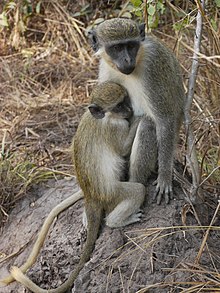Green monkey
| Green monkey[1] | |
|---|---|

| |
| Female with juvenile, Gambia
| |
| Scientific classification | |
| Domain: | Eukaryota |
| Kingdom: | Animalia |
| Phylum: | Chordata |
| Class: | Mammalia |
| Order: | Primates |
| Suborder: | Haplorhini |
| Infraorder: | Simiiformes |
| Family: | Cercopithecidae |
| Genus: | Chlorocebus |
| Species: | C. sabaeus
|
| Binomial name | |
| Chlorocebus sabaeus | |

| |
| Geographic range | |
The green monkey (Chlorocebus sabaeus), also known as the sabaeus monkey,
Physical description
The green monkey is a sexually dimorphic species, with males typically being slightly larger than females. Wild adult males weigh between 3.9 and 8.0 kg (8.6 and 17.6 lb) and measure between 420 and 600 mm (1.38 and 1.97 ft), while the females usually weigh between 3.4 and 5.3 kg (7.5 and 11.7 lb) and measure between 300 and 495 mm (0.984 and 1.624 ft).[4]
Habitat and distribution
The green monkey can be found in a wide range of wooded habitats, ranging from very dry
The green monkey is found in
Behavior
As other members of the genus Chlorocebus, the green monkey is highly social and usually seen in groups. They usually live in groups of 7 up to 80 individuals. Within these groups, there is distinct social hierarchy evidenced by grooming behaviors and gender relationships.
Green monkeys are known to communicate both verbally and non-verbally. They have distinct calls which they use to warn others in the group of predators, and even have specific calls for specific predators. Body language, such as the display of brightly colored genitalia, is also used to communicate danger, but can also be used as a way of establishing dominance. It has also been documented that green monkeys may use facial expressions to express their emotional state.[7]
Reproduction
Green monkeys live in a polygynous society, revolving around the alpha males. The alpha males have control over social interactions and mating between other males and females in the group.
These monkeys are
Gallery
-
Male
-
Male, Senegal
-
Young adult, The Gambia
-
Male, Senegal
References
- ^ OCLC 62265494.
- . Retrieved 18 November 2021.
- ^ ISBN 0-12-408355-2.[page needed]
- ^ a b c d e Cawthon Lang, K. A. (2006). "Primate Factsheets: Vervet (Chlorocebus) Taxonomy, Morphology, & Ecology". Retrieved 2007-08-13.
- ISSN 2074-5737.)
{{cite journal}}: CS1 maint: numeric names: authors list (link - ^ "Monkeys Living Near Florida Airport Connected to 1948 Zoo Escape". Gizmodo. 20 May 2021. Retrieved 22 May 2021.
- ^ Matthew Keller, [1], "Animal Diversity Web", 3/26/12
External links
- View the chlSab2 genome assembly in the UCSC Genome Browser.







